#annual self-promotion post
Text
2022 Writing Income
It’s that time again – for fifteen years now I’ve been writing an annual blog post about my income as a writer. Money tends to be an uncomfortable, even taboo topic, but I think it’s important to help counter the myths that we’re all multimillionaires living in Glass Onion-style mansions. (Side note: If anyone wants to pay millions of dollars for my book, I’ll happily update this blog post from my private island mansion.)
Remember, every writer’s career is different, and I’m only one data point.
Prior Years: Here are the annual write-ups going back to 2007: 2007, 2008, 2009, 2010, 2011, 2012, 2013, 2014, 2015, 2017, 2018, 2019, 2020, 2021.
In 2016, instead of a personal income write-up, I did a survey of almost 400 novelists about their income.
My Background: I’m a primarily “traditionally published,” U.S.-based SF/F author with 15 books in print from major New York publishers. The first of those books came out from DAW in 2006. I have an agent, and have been with them since about 2004.
I’ve self-published a middle grade fantasy and a few short collections. I’ve also sold about 50 short stories to different magazines and anthologies.
I’ve never hit the NYT or USA Today bestseller lists.
I’m currently the sole parent of a teenager (at home) and a 22-year-old (at college). I have a day job that’s just over half-time, both for the paycheck and the benefits.
2022 in Summary: There’s no gentle way to say this. The last several years have kind of sucked. Losing my wife to cancer in 2019 completely derailed my writing. I was hoping 2022 would be a comeback year, but life had other plans…
I did write and sell two new short stories and one nonfiction piece, which was nice. I’ve got a finished middle grade book that’s been on submission for a while. I finished a standalone fantasy that’s been sitting with my publisher for a while.
Normally, my editor is pretty quick about responding, but last year wasn’t normal for DAW, either. DAW was acquired by Astra House. A lot of their time and energy went into that deal. I’m hoping for the best, but things still haven’t settled into the new “normal.”
Last year did see the release — finally — of Terminal Peace, the third book in the Janitors of the Post-Apocalypse series. I’m thrilled and relieved to see that book in print, but it came out right in the middle of the Astra House acquisition, which may have impacted things like promotion and publicity.
I also finished the first draft and started revising a new standalone middle grade fantasy with series potential.
2022 Income: The biggest check was the publication payment for Terminal Peace. All total, before taxes and various expenses, the writing brought in $13,957.16. While that’s absolutely nothing to sneer at, and I’m grateful for the success, it’s also a dropoff from the past couple of years. To be blunt, if you look at the cumulative graph, things have been slumping a bit.

Income Breakdown:
Patreon has been a small but steady and helpful source of income. My thanks to everyone for that!
As usual, my U.S. novels are the biggest piece of the pie. The short fiction category is a bit higher this year, thanks to those two new stories. I didn’t self-publish anything new in 2022, but if that middle grade book doesn’t sell, I’d like to publish that one later this year.
Novels (U.S. editions): $8,542.83
Novels (Non-U.S. editions): $473.25
Self-Published: $1158.24
Short fiction: $892.86
Audio: $521.04
Patreon: $1668.94
Other: $700
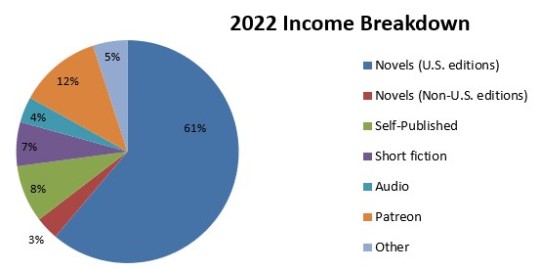
I mentioned earlier that things have been in a bit of a slump, and I need to focus on breaking out of that. Some things I can’t currently control. Tomorrow I could wake up to an offer from DAW on the book they’ve got, and maybe an email from my agent that the middle grade title he’s been shopping around went to auction and got a six-figure advance. But I can’t make these things happen.
Priority #1 is to keep writing. If I’m not doing that, other goals are pretty much moot.
Priority #2 is to figure out some alternate options. It may be time to put more time and effort into self-publishing as a complement to my traditionally published work.
The biggest thing making me anxious is that I’m pretty much out of contract. The paperback of Terminal Peace comes out this year, but for the first time in about 15 years, I don’t have the security, the luxury, or the deadlines of a signed contract. In some ways, this is freeing: I can write whatever I want. But there’s no guarantee as to when things will see print. Submitting to the traditional publishers is a long, slow process…
From talking to other writers who’ve been doing this a while, I’ve learned that pretty much every career has its ups and downs. Personal, pandemic, and publisher issues have been a bit of a perfect storm for me these past few years, but I’m not going anywhere. After 27 years as a writer, I’m excited to see what comes next.
Wrap Up:
I hope this has been helpful. As always, feel free to share the post and/or ask questions.
660 notes
·
View notes
Text
Significant cuts hits IDW's parent company in a self-described "reset"

IDW Media Holdings, the parent of IDW Publishing (the company behind the Sonic the Hedgehog comics), announced major cuts in an effort to unlock financial stability.
The company terminated their New York Stock Exchange listing, shook up senior management, and slashed entire promotional and editorial departments - around 39% of its workforce.
The newly-appointed CEO characterized the axe drop a "reset."
Background
There's no other way to describe it, the cuts at IDW are significant.
The axe drop was in direct response to a poor balance sheet in a tough economic environment. IDW suffered greatly during the COVID-19 pandemic, and non-publishing segments (like direct-to-consumer games) continued to illustrate repeated quarterly losses.
It's no secret that IDW experienced cash flow issues and various others financial challenges, even though the comic books in particular (like IDW Sonic and TMNT) are significant revenue generators.
The company hopes that these cost-cutting measures will provide $4.4 million USD in estimated annual savings.

The impacted
Marketing, public relations, and editorial at IDW were impacted by today's announced cuts.
Comicsbeat reported that the entire marketing and PR departments, and half of the editorial team, got the axe, with more specific details yet to come. That's 39% of the total workforce.
At press time, @idwsonicnews told us that Shawn Lee, a "designer and letterer on many IDW titles", were among the laid off. He tweeted, "whelp, I'm officially a freelancer now."
---
Meanwhile, senior management got a shakeup. Former chairman Davidi Jonas replaced Allan Grafman as Chief Economic Officer. Chief Financial Officer Brooke Feinstein was ousted, and Amber Huerta was promoted to Chief Operating Officer.

IDW also voluntarily delisted their Class B common stock from the New York Stock Exchange, the largest trading venue in the world; and suspended their reporting status to the U.S. Securities and Exchange Commission. The company hoped that this will "reduce pressure on limited resources and the Company’s current inability to realize many of the benefits."
Okay, what about IDW Sonic?
Deep breaths.
At press time, there's nothing we know that flags an immediate concern for the IDW Sonic comics. However, as this is a developing situation, and the long-term outlook is uncertain, the forecast can change.
Even though it, and other comic book franchises (TMNT, etc.) continues to generate significant revenue to the publishing unit, IDW will have to enact more critical decisions to remain financially sound.
IDW Sonic editors David Mariotte and Riley Farmer have yet to officially acknowledge the parent company's announcement, but both "retweeted posts related to the layoffs," @idwsonicnews told us.
We have reached out to IDW Publishing for further comment.
(Updated Friday 11:00 pm ET)
#not great!#idw sonic the hedgehog#idw sonic#idw publishing#sonic the hedgehog#sonic#sonic idw#sonic news
187 notes
·
View notes
Text
I love AO3. I really, truly do. But at the same time, it reminds me that fanfic had a very different feel back in the day… in the late 1990s and early 2000s.
We didn't so much promote our stories as we traded them like literary contraband, handing them out in the back alleys of newsboards and forums and LiveJournal to be gobbled up by the desperate, starving masses. Sometimes you wouldn't post them, you would simply mention that you had written them; and when someone asked to see your story you would send them an email with the creation copy-pasted within. Those of us who had our own Geocities or Angelfire websites would make elaborate pages for each story, setting the background and font color to match what we felt the fic evoked, and of course adding pictures that we had slapped together in Photoshop for flavor.
When FFnet came along, we eagerly thrust our creations into its algorithm, like birds shoving their babies out of the nest; then we held our breath and waited to see if anyone cared enough to make a comment before our stories slipped into the depths of the pit, never to be seen or read again. And the tingle we felt in our chests when someone did finally comment left us on a high for hours or even days.
There were annual fanfiction awards for some fandoms, and if you won any category at all you would wear that award proudly... a badge of honor to be displayed in your forum signature or FFnet profile. But really, the ultimate honor was when someone did fan art of your stories and posted it on DeviantArt or LJ, and you would hold on to that picture like a child clinging to a favorite teddy bear.
More often than not, the people you knew in real life weren't aware of what you did with your spare time, and you would have died of embarrassment if they ever found out. In general, you stayed in your lane, keeping other fandoms out of your business, except for the occasional crossover (which came with the added complication of having to choose which fandom to post them under on FFnet). We didn't have beta readers... hell, sometimes we didn't edit at all. Grammar and spelling mattered less than your passion for the subject, and research was conducted somewhat haphazardly, to the point where any anachronisms were shrugged off. Still, OOC characters were raked thoroughly across the coals; questioned and poked until the author explained why they had written them that way.
The tropes and cliches that people now cringe at were created then, embraced wholeheartedly. Mary Sues and self-inserts and songfics were everywhere… and we loved it. Authors would interrupt their own stories in the middle to add notes, sometimes presented as the characters themselves giving you information about what was going on in the story or what led the author to add this or that small detail.
We were afraid of being copyright claimed, we were afraid of being ridiculed, we were afraid of being sued by Anne Rice (even if we didn't write anything that took place in her universe). We felt rebellious, accomplished, and maybe a little guilty about what we wrote; but we wrote it because we loved it, and that was enough.
As I said, I really do love AO3… but there was just such a culture surrounding fanfic back then… a kinship and a sisterhood. I wish that those who have never gotten to experience it could have the chance to go back for a while, feel the way it felt… same as I wish my own kids could have experienced the freedom of summer vacation back when summer vacation meant freedom.
The world is just too fast now, the internet too loud; you have to run to catch up, scream to be heard... when sometimes all you want to do is whisper, "Hey… I wrote something… does anyone want to take a look?" and to have someone whisper back, "Yes! Send it to me and I'll print it out to read in bed tonight!"
607 notes
·
View notes
Note
Izuku isn't one to keep grudges. He'd rather bury the hatchet & move on. But when word got out that Bakugō's past as a bully & an abuser got exposed at the latest annual Hero Gala, where he just got promoted to the #1 Hero no less, Izuku couldn't deny the small feeling of satisfaction within him. Soon, Bakugō lost the respect of his fellow Class 1-A graduates, former UA teachers, most of Japanese citizens & the whole world. His Hero license got revoked. He becomes what Izuku used to be. An outcast. A social pariah.
:))))))))))))))))))))))))))))
TW: this will discuss bakugou’s abusive behavior towards izuku, internal conflict, self blaming, social media harassment and bullshit, etc.
When I tell you I love karmic retribution
Izuku had kept quiet about the abuse he had faced at the hands of bakugou (and previous classmates and teachers) for so goddamn long
He had guiltily hoped that someone would fucking realize. Understand. Believe him. Stand up for him. Anything.
He had felt so selfish about wanting this, but it was such a deep and intrinsic feeling
He’s a goddamn kid, he just wants someone to tell him that what he’s gone through isn’t fair. That he didn’t deserve that. That no one, including he, deserves that. That he is worth kindness. That he is worth care. That he is just fucking accepted.
And lord knows he has had his daydreams of revenge. So many. Like so fucking many.
Spiteful revenge is a very helpful way to get through the day.
So, when it eventually came out about what bakugou had done to him for so long. He did feel vindicated.
Somehow, videos from Aldera had surfaced online.
Those who hadn’t liked bakugo prior to seeing them came out of the woodworks. They were loud and everywhere.
Bakugou asked izuku to speak out on it, stand up for him. Only then, did izuku break
He had been quiet on the issue for months. Decades, really.
He made a short and concise post on whatever social media platform people use in bnha essentially saying that yes, bakugou had done those things. Yes, bakugou’s behavior was unacceptable. He never spoke out about it because he did not have reason to think that he would be believed and that he doubted any change would be made.
He does not discuss his personal feeling about bakugou. He does starts up an anti-bullying campaign.
Bakugou quickly falls from the fickle grace that is social media
People reach out to izuku left and right apologizing to him and asking if he’s okay and good fucking gods does it suck
Because they only care now that he’s useful to them
He is so conflicted and he really just does not want to talk about it. It quickly becomes known that it is a touchy subject and one that hero Dekiru refuses to speak on.
Does that stop people from asking about it? No.
Eventually, things settle
Eventually, bakugou ends up making a large donation to the campaign izuku started.
They never become friends. Izuku doesn’t even forgive bakugou. That’s okay, it’s not needed. They do get to a point where they can see each other walking in the street and acknowledge the other. No words, just acknowledgement.
I hope you liked this!!!! If bakugou is your favorite character and you think this is stupid, that is fine!
Thank you for the ask!!! :D
27 notes
·
View notes
Text
Honouring Truth and Reconciliation Day: Remembering the Importance of Orange Shirt Day
Shaina Tranquilino
September 30, 2023

In recent years, there has been a growing recognition of the importance of truth and reconciliation in acknowledging and healing the wounds caused by historical injustices. Canada's Truth and Reconciliation Day, recognized on September 30th annually, serves as a crucial reminder that understanding our past is essential for building a more inclusive and harmonious future. In conjunction with this day, Orange Shirt Day stands as a poignant symbol of remembrance and reflection concerning the devastating impacts of residential schools. This blog post aims to shed light on both events' significance and highlight why they deserve our attention.
1. Understanding Truth and Reconciliation:
Truth and Reconciliation Day holds immense value as it acknowledges the painful history experienced by Indigenous peoples in Canada due to colonization policies such as the Indian Residential Schools system. The objective is not only to remember but also to foster an environment where dialogue, empathy, and understanding can flourish between Indigenous communities and non-Indigenous Canadians.
2. Recognizing Orange Shirt Day:
Orange Shirt Day complements Truth and Reconciliation Day by focusing specifically on raising awareness about residential schools' traumatic legacy. Initiated by Phyllis Webstad's story when her new orange shirt was taken from her upon arrival at a residential school, this day reminds us of the countless children who were stripped of their culture, language, identity, dignity, and familial bonds.
3. Learning Lessons From Our Past:
By commemorating these days collectively, we acknowledge that recognizing historical wrongs paves the way for healing intergenerational trauma. It prompts us to reflect on how similar systemic injustices persist today within various societal structures—education systems, healthcare disparities, judicial processes—among others.
4. Promoting Education & Awareness:
Educating ourselves about Indigenous history should extend beyond one designated day or month; however, Truth and Reconciliation Day provides an opportunity for all Canadians to engage in learning about the diverse cultures, traditions, and contributions of Indigenous peoples. It encourages us to become active participants in reconciliation efforts by challenging stereotypes and fostering inclusive spaces.
5. Fostering Reconciliation:
Reconciliation is a journey that involves listening, understanding, respect, and dismantling systemic barriers. On this day, let's strive for meaningful reconciliation by recognizing the rights of Indigenous peoples and promoting their self-determination while building bridges between communities based on mutual trust and understanding.
Truth and Reconciliation Day signifies an essential step towards healing historical wounds, acknowledging past injustices, and promoting unity among Indigenous and non-Indigenous communities. Together with Orange Shirt Day, it reminds us that we must confront uncomfortable truths if we genuinely seek reconciliation in our society. Let us embrace these days as opportunities to learn from our history, amplify Indigenous voices, work towards positive change, and build a future where cultural diversity thrives within an atmosphere of truth, compassion, justice, and respect for all.
#truth and reconciliation day#orange shirt day#every child matters#end colonialism#healing generations#honouring survivors#indigenous rights#residential school legacy#remembering the children#reconciliation journey#justice for all
48 notes
·
View notes
Text

On January 18, 2023, as thousands of Peruvians were taking to the streets in Lima to denounce the spiralling political crisis in the country, Canadian Ambassador Louis Marcotte was meeting with the Peruvian Minister of Energy and Mines.
Protests have been ongoing since December [2022] [...]. Demonstrators have been met with widespread arrests and brutal violence. According to Yves Engler, since [protests began] [...] the Canadian mission has met with numerous top-level Peruvian officials in unprecedented fashion. [...] Ambassador Marcotte tweeted several photos from the meeting, using the occasion to promote mining as a benefit for communities and to express Canadian support for the upcoming Peruvian delegation who will attend the Prospectors and Developers Association of Canada’s (PDAC) annual conference in Toronto from March 5 to 8. Each year, the world’s largest mining convention draws tens of thousands of industry experts, company officials, and government representatives to talk industry trends and promote an expansion of mining -- with little concern for the consent of those most affected, including in Peru. [...]
For years, MiningWatch Canada and the Justice and Corporate Accountability Project (JCAP), alongside organizations including Red Muqui, Cooperacción, Derechos Humanos Sin Fronteras-Cusco and Derechos Humanos y Medio Ambiente DHUMA, have documented the many harms caused by industrial large-scale Canadian mining to rural communities, as well as the associated police violence that often accompanies the imposition of these projects. [...] [T]he systematic and often violent exclusion of Indigenous, peasant and rural peoples from the political economic system, as well as the legacies of land dispossession and contamination, are indeed linked to centuries of extractivism.
The ambassador’s tweet has to be taken within a context of centuries of colonial and decades of post-colonial violence against rural peoples at the behest of resource extraction. [...] Ambassador Marcotte chose to promote more Canadian mining investment in the country and plug PDAC 2023 -- where a session dubbed “Peru Day” promises to discuss “opportunities [...].” Canada’s priorities in Peru could not be more clear. [...]
---
Canadian companies invested over $8 billion in 10 projects [in 2021] [...]. Toronto-based Hudbay Minerals operates the Constancia mine; Vancouver’s Pan American Silver operates the Shahuindo and La Arena mines; and Teck Resources’, also headquartered in Vancouver, operates the Antamina mine, with a 22.5 percent ownership stake in the project. Antamina is Peru’s largest mine, ranking among the top 10 producing mines in the world in terms of volume, and is the single most important producer of copper, silver, and zinc in the country. In 2021, the mine generated over $6 billion in revenue and nearly $3.7 billion in gross profits. [...]
---
When Canadian mining companies are embroiled in a conflict with local communities [...] [in] Peru, companies benefit from state-sanctioned police protection and impunity. Companies can sign service contracts directly with the National Peruvian Police, and off-duty police officers are permitted to work for private security companies while using state property, such as weapons, uniforms and ammunition. [...]
Violence isn’t only used against rural peoples at blockades or during massive marches; it’s a daily occurrence [...].
As the Cusco-based organization Derechos Humanos Sin Fronteras has demonstrated through several environmental and social impact studies related to Hudbay’s Constancia mine, these contracts not only permit explicit state violence, they also form the backdrop of racialized and class-based intimidation and threats [...].
---
These harms are not minimal: contamination of agricultural lands and waterways around Pan American Silver’s Quiruvilca mine and the criminalization of community leaders and land dispossession due to environmental contamination at Shahuindo; violation of Indigenous self-determination and the right to a clean environment around Plateau Energy’s proposed lithium and uranium mine, sitting atop the region’s most important tropical glacier; undercutting of economic benefits for communities most affected by mining operations, and more.
---
Yet the Canadian embassy in Peru has a track record of ignoring the concerns of human rights and environmental defenders affected by Canadian mining projects in the country -- even ignoring the concerns of Canadian citizen Jennifer Moore who was detained in 2017 by Peruvian police while screening a documentary film with Quechua communities affected by Hudbay’s Constancia mine. Moore, who was subsequently banned from re-entering the country [...], is the focus of a recent report by the Justice and Corporate Accountability Project (JCAP) on the role of Canadian embassies in prioritizing the interests of Canadian mining companies at the expense of their own policies and commitments regarding the protection of human rights defenders. [...]
But it should be made clear: when the [Canadian] embassy chooses to promote mining in Peru during PDAC, it is doing so knowing the reality of what these activities mean for people who are facing ongoing threats, intimidation, and explicit state-sponsored violence.
---
Headline and text by: Kirsten Francescone. “State-sanctioned violence in Peru and the role of Canadian mining.” Canadian Dimension. 6 March 2023. [Bold emphasis and some paragraph breaks and contractions added by me.]
88 notes
·
View notes
Text
Traditionally incoming Argentinian presidents give an inauguration speech inside of Congress to other politicians. Javier Milei, a former “tantric sex instructor” turned libertarian economist, symbolically gave his speech with his back to the Congress facing towards the people.
“For more than 100 years, politicians have insisted on defending a model that only produces poverty, stagnation, and misery,” President Milei said. “A model that assumes that citizens exist to serve politics, not that politics exists to serve citizens.” He also promised an “end a long and sad history of decadence and decline” and promote a new era based on peace, prosperity, and freedom.
Since his headline-making election victory last month, media portrayal of Milei has ranged from dismissive to condescending, often depicting him as an eccentric “far-right populist.” Yet, since taking office, Milei has shelved many of his campaign’s more contentious proposals and begun implementing a radical but, by international standards, orthodox reform plan to revitalize Argentina’s faltering economy.
Milei inherited a challenging situation. Argentina’s economy has shrunk by 12 per cent over the last decade, annual inflation reached an extraordinary 160 per cent in November, while the poverty rate increased to 40 per cent in the first half of 2023.
Argentina has a fascinating economic history that led up to this point. In the 19th century post-independence Argentina adopted a liberal constitution that helped deliver an impressive economic expansion.
By the early 20th century, Argentina was one of the world’s richest countries, driven by agricultural exports. Real wages were comparable to Britain and only slightly below the United States. Millions fled destitution in southern Europe for a new life in Argentina. Buenos Aires has been labelled the “Paris of South America” because of spectacular neoclassical architecture built during this era.
This turned to disaster over the subsequent decades because of collectivist rule – from military dictatorships to avidly socialist leaders. Argentina nationalised industries, subsidised domestic production, limited external trade, and introduced an unaffordable welfare state. This has become known as the Peronism, named after 20th century president Juan Domingo Perón, a leftist populist leader who supressed opposition and controlled the press.
This agenda accelerated in recent decades under self-identifying Peronist leaders, turning Argentina into one of the world’s most closed and heavily regulated countries. The latest Human Freedom Index places Argentina at 163rd in the world for openness to trade and 143rd for regulatory burden. This has culminated in an economy on the precipice of economic disaster.
Not wasting any time, Milei has proposed a mega package of over 350 economic reforms to open the economy and remove regulatory barriers. This includes privatising inefficient state assets, eliminating rent controls and restrictive retail regulations, liberalising labour laws, lifting export prohibitions, and allowing contracts in foreign currencies.
There has been a notable absence of some of most radical ideas – such as legalising organ sales or banning abortion. He has also put on hold plans to dollarise the economy and abolish the central bank. Instead, at least by international standards, the agenda contains several orthodox economic reforms.
Many of the measures – such as cutting spending to get the deficit (currently at 15 per cent of GDP) under control, opening the country up to international trade, and liberalising the airline industry through ‘open skies’ policy – would be required to join the European Union. The government is eliminating capital and currency controls and allowing the peso to devalue – measures that the IMF’s managing director Kristina Georgieva said these are important to stabilise the economy.
There are undoubtedly significant challenges ahead and some darker elements to agenda.
Milei has been, uncharacteristically for a politician, honest that “in the short term the situation will get worse”. The removal of price controls, for example, will increase inflation until demand and supply can stabilise to end shortages. But, he says, “then we will see the fruits of our efforts, having created the foundations of a solid and sustainable growth over time.”
The government is facing significant opposition, with the union movement organising mass protests and threatening a general strike. The government has responded by proposing questionable new anti-protest laws, that include lengthy jail sentences for road-blocking and requirements to seek permission for gatherings of more than three people in a public place. Milei, who could struggle to get much of his agenda through Argentina’s Congress, is asking for sweeping emergency presidential powers until the end of 2025. This raises serious questions about democratic accountability.
Nevertheless, there are some positive early signs. Since Milei’s election Argentina’s flagship stock index has risen by almost one-third and the peso’s value has not collapsed. Argentina could soon benefit from a major new shale pipeline pumping one million barrels of crude a day (helped along by reforms that allow exports of oil and sales at market prices) and the mining of the second largest proven lithium reserves in the world.
Argentina has long served as a solemn reminder that prosperity is neither inevitable nor unassailable. Misguided policies can transform mere challenges into a profound crisis. Milei is offering a glimmer of hope: redemption may just be possible. Let’s also hope that Britain’s leaders can similarly take the path of reform, ideally before things get as bad as Argentina.
Matthew Lesh is the Director of Public Policy and Communications at the Institute of Economic Affairs
11 notes
·
View notes
Text
LGBTQ Etsy Shops 2022
Pride season is coming up, which means it’s time for my annual “support queer creators!” post.
Due to the recent debacles with Etsy, I encourage people to check and see if shops have other platforms (i.e., their own website, Shopify, etc.) that they prefer people to buy from. But if not, many shops are okay with you buying through Etsy! It’s better than not supporting them at all. For that reason, most of these shops are on Etsy, but some of the links direct to other websites.
Here is a (non-exhaustive) list of shops and what they sell!
TheQueerSphere - buttons and stickers
AvianDalek - buttons, stickers, and prints
HowdyItsJunebug - stickers, zines, and buttons
HateKillRepeat - stickers and patches
GayCrochetShop - plushies, scarves, hats, and more
Catmint Studios - stickers, buttons, enamel pins, and keychains
CrochetingAce - crocheted plushies
MinichelleDesigns - stickers, pins, and more
ChaoBunnyArts - washi tape and enamel pins
LilacWonderland - buttons, stickers, and jewelry
Queerkwe - earrings, other jewelry, and stickers
LavenderMinis - enamel pins and plushies
In Rainbows - pins, stickers, apparel, and more
MartianArts - stickers, buttons, prints, and more
QueerPrideUS - stickers, postcards, and more
GenderPlasmic - apparel and zines
Feel free to add on, especially with your own shops (whether they’re on Etsy or not)! Don’t be afraid to self-promote!
479 notes
·
View notes
Text
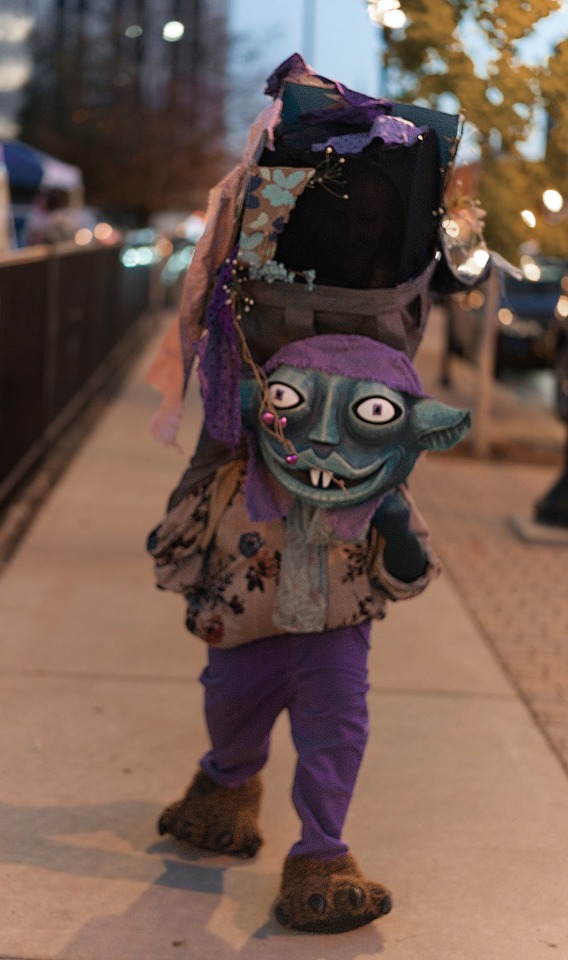






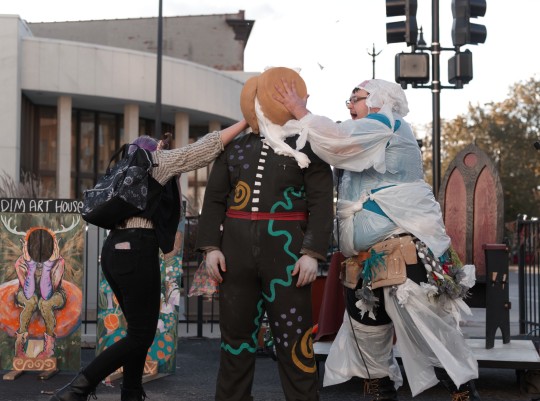
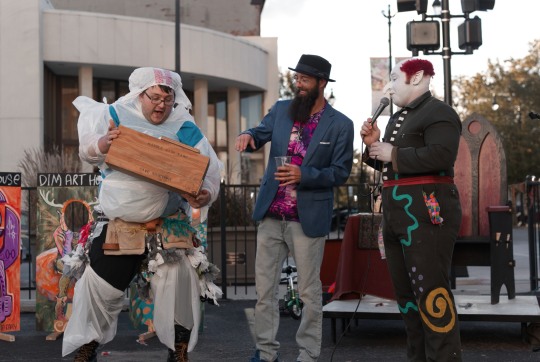

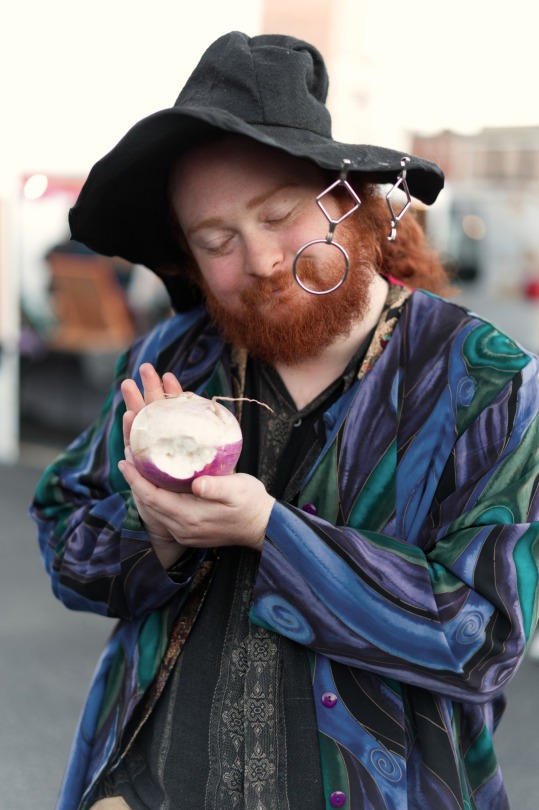

So I'm terrible at social media. TERRIBLE at self promotion. But it's okay, I don't have too many followers that would have been able to go to this.
With the help of a group of friends I hosted a goblin and fairy art show! We had 30 artists, a competition & coronation of the goblin lord, goblin CLOWNS, and so many wonderful costumes.
We've decided we are going to do this annually too. So if you live near the Central IL area, Springfield is going to be slowly building a ren faire focusing on the arts. This is the second year the This Is Fae Propaganda Art Show has been done, and now that we have a team working on it, there will be more to come.
I'll also have a couple of posts coming out with videos of our chaotic goblins as well as what weird art I made for my booth.
#goblincore#fae propaganda#fairy aesthetic#fairycore#art fair#ren faire#art shows#fairies#fantasy art#fairy#goblin aesthetic#gobtober2023#dark fantasy#urban fantasy#art gallery#art#artists on tumblr#artistsupport
17 notes
·
View notes
Text
Weekly Press Briefing #90: March 10th - 16th
Welcome back to the Weekly Press Briefing, where we bring you highlights from The West Wing fandom each week, including new fics, ongoing challenges, and more! This briefing covers all things posted from March 10 - March 16, 2024. Did we miss something? Let us know; you can find our contact info at the bottom of this briefing!
Challenges/Prompts:
Do you have a challenge or event you’d like us to promote or know of one we’re missing? Be sure to get in touch with us! Contact info is at the bottom of this briefing.
@thefinestmuffin and @JessBakesCakes are hosting the 3rd Annual Josh/Donna Rom-Com Fest. The fest revealed on February 14, but prompts and claims are still open and fics can still be added to the collection. Details here.
This Week in Canon:
Welcome back to This Week in Canon, where we revisit moments in The West Wing that occurred on these dates during the show’s run.
Season 2, Episode 17: The Stackhouse Filibuster aired on March 14, 2001.
Season 6, Episode 19: Ninety Miles Away aired on March 16, 2005.
Season 7, Episode 13: The Cold aired on March 12, 2006.
Photos/Videos:
Here’s what was posted from March 10 – March 16:
Dule Hill posted a video in support of fundraising for Private School Axis in LA.
Dule Hill posted photos of himself and his family getting ready for and attending the NAACP Image Awards.
Marlee Matlin posted photos from her daughter’s baby shower.
Mary McCormack posted family photos in memory of her mother, who has passed away.
Peter James Smith posted a screenshot of his recent audition self-tapes.
Rob Lowe posted photos from Oscars night.
Rob Lowe posted a photo of himself and his sons next to a Lowe motorboat.
Donna Moss Daily: March 10 | March 11 | March 12 | March 13 | March 14 | March 15 | March 16
Daily Josh Lyman: March 10 | March 11 | March 12 | March 13 | March 14 | March 15 | March 16
No Context BWhit: March 10 | March 12 | March 14 | March 15 | March 16
@twwarchive: March 10 | March 11 | March 12 | March 13 | March 14 | March 15 | March 16
@janneyupdates: March 13 | March 14 | March 14 (2)
Editors’ Choice:
In honor of the anniversary of the premiere of 7.13 “The Cold”, have some of our favorite fics centered around or involving that episode! Be sure to share some of your favorites, too.
i’m all for you (body and soul) by hanyolo | Rated G | Josh Lyman/Donna Moss | Complete | Josh sits back with a dejected sigh, can’t help but think that maybe this is just one of those things, yet another reminder from the universe that he and Donna aren’t meant to happen.
But it doesn’t feel like that anymore. Not after this morning, not after the terrible year he spent without her. No, it feels like maybe the stars are finally aligning, like this might be their last chance, so he jumps to his feet, all but pushing Bram aside as he sidesteps the table and jogs the length of the terrace.
“Josh, what —“ Ronna starts to ask him, but he ignores her, can feel both her and Bram watching him with a burning curiosity as he tries to stop her before it’s too late.
// me watching the cold: i can fix that
your heart on my mind by hufflepuffhermione | Rated T | Josh Lyman/Donna Moss | Complete | It's as if looking at her can trigger a memory, and any facts he’s supposed to be using to corral donors slip his mind when he looks at her and feels her lips on his again. I feel terrible, he had told her, but he might have been lying, because even some of the best polls he’s seen over the course of this brutal campaign don’t make him feel as good, as warm, as the memory of that morning last week.
Josh can't stop thinking about the first time he and Donna kissed.
the other side of the door by sam_writes_fics | Rated M | Josh Lyman/Donna Moss | Complete | Donna wanders out of the bathroom, baffled by how late it is for the hundredth night in a row, and she drapes her coat over a chair before moving to plug in her cell phone. The blinking light catches her attention, and she flips it open.
One missed call.
From Josh.
Perfect.
// post-ep for 7x13: The Cold
With One Hello, I’ll Never Be the Same by JessBakesCakes | Rated T | Josh Lyman/Donna Moss | Complete | “Hi.”
“Hi.”
It's all he can say at the moment - they've always been able to say so much with just one word, and this moment is no different.
Or: Josh and Donna and how 'hi' means so much more than 'hello'.
cause you know that it’s delicate by pumpkinpatch95 | Rated T | Josh Lyman/Donna Moss | Complete | "It was new, the two of them eating lunch together."
5 times Josh and Donna snuck in dates, starting when she joined the Santos campaign. 5 times they got caught.
Fics:
Presenting your weekly roundup of fics posted in the tag for The West Wing on Archive of Our Own.
Josh/Donna
Somebody Loved by JessBakesCakes | Rated G | Josh Lyman/Donna Moss | Complete
Self-Evaluation by Telperien | Rated T | Josh Lyman/Donna Moss | In Progress
Abbey/Jed
The First Lady by unseenacademic | Rated T | | Abbey Bartlet/Jed Bartlet | In Progress
We had a deal by Labda | Not Rated | Abbey Bartlet/Jed Bartlet | In Progress
Other Pairings/Gen Fic
it started off with a kiss... now it ended up like this by imawkwardlysoc | Rated G | Sam Seaborn/Original Female Character | Complete
An Intriguing Variable by silasfinch for justdreaming88 | Rated T | Ellie Bartlet/Original Female Character(s) | In Progress
Multiple Pairings
Children of the Apocalypse by murph283031 | Rated T | Leo McGarry/Annabeth Schott, Josh Lyman/Donna Moss, Mallory O'Brien/Sam Seaborn, Abbey Bartlet/Jed Bartlet | In Progress
THE WEEKLY PRESS BRIEFING TEAM CAN BE REACHED VIA THE FOLLOWING METHODS:
Twitter: @TWWPress
Email: [email protected]
Feel free to let us know if we missed something, if you have an event you’d like us to promote, or if you have an item that you’d like included in the next briefing!
xx,
What’s next?
#weekly press briefing#the west wing#tww#tww fandom#tww fic#west wing#josh lyman#donna moss#cj cregg#sam seaborn#toby ziegler#the cold#joshdonna#abbeyjed#tww rare pairs
4 notes
·
View notes
Text
Headcanon: Why Data Had Never Painted Until Geodri Taught Him
USS Tripoli
The Tripoli was the ship which found and reactivated Data. It was aboard the Tripoli that he first became self aware. However, he had very little further opportunity for self discovery, as the Captain regulated that he only be activated when accompanied by one of the crew - at all other times, he was switched off and kept in a designated storage cupboard. While a few members of the crew were kind to him, few saw him as a legitimate being and therefore he wasn't encouraged to pursue any sort of hobbies or interests. Whenever he did show interest, he was reminded that he was an android and did not need such outlets.
Starfleet Academy
Here, while Data excelled in his studies, he failed at socialization. His time on the Tripoli had taught him very little about how to interact with other sentients as equals. While he wanted to experience making friends, as he saw his classmates do, he neither knew how now expected that they would want an android as a friend. This lack of interaction resulted in very few opportunities for exploring interests. He did spend a great deal of time in the library, setting a record for the most books ever checked out by any cadet in history, and exploring San Francisco.
Outposts
Data worked at a series of outposts, research centers, and starbases between 2345 and 2360. Most were lightly crewed, the remote or dangerous postings that most other officers would resist, and he was often the only crew member of these bases. It was during this time that he was promoted from ensign to lieutenant, although he suspects that the reason was so that he would no longer require a supervising officer on site.
USS Trieste
The Trieste was Data's first posting on a starship, shortly after being promoted to lt. commander. There, however, he had few opportunities for any personal time as, discovering that he needed neither rest nor sleep resulted in the Captain booking him for every shift. He worked almost non-stop in the years that he was posted on that ship. The one exception, the one 'holiday', each year was an annual cybernetics conference at which he was always a featured speaker. It was at one of these conferences that he met Geordi, who went out of his way to befriend him. They continued a correspondence and, in one of those letters, Geordi promised to teach him how to paint, a promise kept once they were both assigned to the Enterprise.
Excerpts from those letters...
Data, sent 0131, Stardate 129348.02: Geordi, while I appreciate your encouragement, I do no believe that I would be capable of performing the specified task. Art is considered an expression of inner feeling. While I could produce a reasonable facsimile, it would lack that ineffable quality of expression.
La Forge, sent 0803, Stardate 129361.68: That's ridiculous and I think you know it. You're too used to snapping your fingers and instantly knowing something. Art isn't like that. It's something you have to learn, have to practice. I think you could, you just need someone to teach you.
Data, sent 0906, Stardate 129362.02: In what way would snapping my fingers produce knowledge of any kind?
15 notes
·
View notes
Text

Annual Award Eligibility Post
The obligatory award-related self-promotion post!
4 notes
·
View notes
Text

By: David Millard Haskell
Published: Feb 15, 2024
Almost two months ago, Tesla CEO and Twitter (now X) owner Elon Musk, made critical statements on X about the field of diversity, equity, and inclusion (DEI). In a post that’s now been viewed nearly 36 million times, Musk stated “DEI must DIE. The point was to end discrimination, not replace it with different discrimination.”
Recently, Musk showed he was willing to do his part to hasten DEI’s demise. In its official filings with the US Securities and Exchange Commission, Tesla did a clean sweep of DEI language and references to DEI initiatives. The world’s largest electric vehicle manufacturer is now DEI-free.
Musk’s comment and related actions reflect a growing consensus that DEI ideology and instruction—educational materials steeped in critical social justice and offered as mandatory training by most corporations, educational systems and government agencies—does not work.
That is, it fails to deliver on its promise to reduce prejudice and produce greater harmony among groups. Ironically, as Musk observes, it appears to promote the divisive concept popularized by self-proclaimed “anti-racism” scholar and DEI guru, Ibram X. Kendi, that “the only solution to past discrimination is present discrimination.”
In the US, several high-profile controversies have further solidified the connection between questionable concepts (like Kendi’s) promoted in DEI training and reverse discrimination against Caucasians as well as academically successful Asians, and Israel-supporting Jews.
There have been similar DEI-influenced controversies in Canada. The suicide of Toronto public school principal Richard Bilkszto awakened many to the destructive nature of this caustic curriculum. When announcing his death, Bilkszto’s lawyer traced his deteriorating mental health and ultimate demise to a series of diversity, equity and inclusion workshops he had attended. (The allegations have not yet been proven in court.)
Recordings show that Bilkszto was subjected to repeat harassment and humiliation based on his skin colour after he politely questioned the DEI trainer about one of her claims.
Shortly after Bilkszto’s death in July of 2023, the trainer in question, Kiki Ojo-Thompson, released a statement on the website of her consulting company, the KOJO Institute. It said: “This incident is being weaponized to discredit and suppress the work of everyone committed to diversity, equity, and inclusion” which is “building a better society for everyone.”
But is it true that the concepts and training of DEI builds “a better society for everyone?”
This was a question that the Aristotle Foundation for Public Policy asked me to answer. To do that I examined the findings of the most significant DEI studies from recent decades published in top social scientific journals like the Annual Review of Psychology, Anthropology Now, Journal of Experimental Psychology, Psychological Science, and Journal of Personality and Social Psychology. Authors of the reviewed literature are from various universities including Harvard, Princeton, Yale, Michigan, Syracuse, Aberdeen and others.
What the research shows is surprising—for some. For example, claims that “DEI works!” are not supported; multiple meta-analyses of hundreds of studies could not discern any clear evidence that DEI instruction changes people’s attitudes for the better.
In one particularly damning analysis, the researchers concluded “Implementation of DT [Diversity Training] has clearly outpaced the available evidence that such programs are effective in achieving their goals.”
On the other hand, the research provides clear proof: DEI instruction can activate and even increase bigotry among participants.
You’d think that such a conclusion would cause our corporate, academic, and political leaders to immediately withdraw the millions they’re spending on DEI programs and DEI staff. But old habits die hard, especially when those enforcing the habits have to admit that they’ve been hoodwinked.
The practice of blood-letting lasted more than one thousand years and only began to fall out of fashion in the mid-1800s when a Parisian physician, Pierre Louis, finally decided to measure patient outcomes. To his surprise, the application of leeches to a person’s back or the cutting and draining of the vein at their elbow didn’t do anything positive and could make matters worse.
We now can say the same about DEI.
History is riddled with instances of scholarship exposed as snake oil. Let’s learn our lesson: In the absence of evidence, you need to throw out the leeches.
David Millard Haskell is the author of “What DEI research concludes about diversity training: It is divisive, counter-productive, and unnecessary.” He is a professor and researcher at Wilfrid Laurier University and a Senior Fellow with the Aristotle Foundation for Public Policy.
--
By: David Millard Haskell
Published: Feb 12, 2024
Introduction
In July 2023, public school principal Richard Bilkszto killed himself. When announcing his death, Bilkszto’s lawyer traced his deteriorating mental health and ultimate demise to diversity, equity, and inclusion (DEI) workshops his school board required him to attend.1 Recordings show that he was harassed and humiliated by the DEI trainer for questioning one of her claims.2
A growing number of high-profile cases suggest that diversity workshops and their supporting materials regularly promote questionable claims—particularly about the overarching, malicious character of the majority population.3 Similarly, hostility toward those who challenge DEI claims is part of the pattern.4 In Canada, students who challenge claims have been punished or expelled5; employees have been suspended.6 One whistleblower who leaked DEI training session material maligning the majority population lost his employment.7
While the hostility Bilszto was subjected to during his DEI training is not unusual, his extreme response to it is an outlier. But it also sounds an alarm. It draws our attention to the potentially negative nature of this instruction that is now ubiquitously conducted— usually as a mandatory exercise—in most corporations, educational systems, and government agencies.
The DEI training that Bilkszto attended focused heavily on race; this is typical. While DEI instruction can be as varied as it is pervasive, so-called “anti-racism education” tends to get the most attention during workshops.
Supporters justify DEI training—in particular, the “anti-racist” variety—with the argument that Canada, and Western nations generally, are systemically racist. The logic is this: the medicine must be applied everywhere because the disease is everywhere.
Specifically, DEI advocates assert that discrimination against minorities, while not explicit, is embedded in society’s institutions, and therefore leads to disparities. They hold up any difference in outcomes between the country’s majority and minority populations— at least when they skew negatively for the minority—as obvious proof of systemic racism.8
However, a rudimentary understanding of statistical analysis leads to the conclusion that it is in fact not “obvious” that differences in outcomes between racial and ethnic cohorts are evidence of racism; correlation does not equal causation. In fact, in his recent Reality Check on systemic racism claims in Canada, the Aristotle Foundation’s Matthew Lau evaluates the empirical data and comes to this conclusion:
If the typical anti-racism activist in Canada today is looking for widespread institutional or systemic racism… they will not find it.
…Moreover, the data on disparities in income, educational attainment, occupational outcomes, and public school test scores show that, on average, Asians are doing better than the white population.9
Operating under the assumption that society is overrun with intolerance, the expressed goal in DEI workshops is to generate harmony amongst diverse populations. To that end, independent consultants or in-house DEI staff lead participants through a curriculum focusing on such concepts as implicit bias, white privilege, and micro-aggressions.
With reference to the existing scholarship, this Reality Check investigates whether diversity, equity, and inclusion instruction actually leads to greater harmony and tolerance—or to the opposite. As we will see, the national and international research10 shows there is often a disconnect between the evidence and the claims of DEI advocates. (See the appendix table for a short summary of the literature on DEI instruction.)
Diversity training in practice: Aggressive, and justified by circular “proofs”
To “prove” the effectiveness of DEI instruction, proponents often point to surveys conducted before and after workshops that show, following training, participants are much more likely to articulate answers that align with the pro-DEI ideas. That is to say, someone who takes the training can, afterwards, recite what they were told. In these testimonials it is seldom mentioned that for many participants job security and career advancement is contingent on giving the “right” answers.11
This type of methodology has drawn criticism and has proven to be unreliable. In a 2022 article, after reviewing the scholarly literature on DEI instruction, psychological researchers Patricia Devine and Tory Ash concluded that scholars of diversity training “too often use proxy measures for success that are far removed from the types of consequential outcomes that reflect the purported goals of such trainings.”12
A disconnect between DEI claims and DEI outcomes: A look at the literature
Despite criticism of their methods, proponents of DEI instruction continue to assert that it is effective. “Effective,” for them, means more than just reciting talking points from a workshop, they claim that their programs actually change behaviour. Websites and public documents from independent DEI consultants and in-house DEI office staff promise that because of their instruction, workplace harmony, productivity, and collaboration across groups will increase, discrimination will be reduced, and bias and bigotry will be lessened.13
However, the research does not support claims of behavioural change. For example, in their 2018 article “Why Doesn’t Diversity Training Work?” published in Anthropology Now, Harvard Sociologist Frank Dobbin and colleague Alexandra Kalev observed:
Nearly all Fortune 500 companies do training, and two thirds of colleges and universities have training for faculty according to our 2016 survey of 670 schools. Most also put freshmen through some sort of diversity session as part of orientation. Yet hundreds of studies dating back to the 1930s suggest that antibias training does not reduce bias, alter behaviour or change the workplace.14
Supporting Dobbin and Kalev’s observation, numerous systematic reviews and meta-analyses—an advanced research method that combines the data of multiple studies to identify overall trends—have determined that the ability of DEI training to elevate harmony and/or decrease prejudice (in any lasting way) is undetectable or negligible.15 Those systematic reviews and meta-analyses are cited in this paper’s endnotes; however, for the purpose of illustration, the key findings of some of the most significant and representative works are discussed below.
In a review of all available research between 2003 and 2008 focusing on the impact of DEI programs, Elizabeth Paluck, then at Harvard and now at Princeton, and Donald Green at Yale generated a sample of 985 studies. After aggregate, statistical assessment they concluded:
… the causal effects of many widespread prejudice-reduction interventions, such as workplace diversity training and media campaigns, remain unknown… Due to weaknesses in the internal and external validity of existing research, the literature does not reveal whether, when, and why interventions reduce prejudice in the world.16
Updating her research in 2021 with a second meta-analysis of over 400 current studies, Paluck and colleagues again found little evidence that instruction in diversity, equity, and inclusion works to decrease prejudice. They begin by stating: “Although these studies report optimistic conclusions, we identify troubling indications of publication bias that may exaggerate effects.”17
They then clarify what they mean by “exaggerate effects.” When examined through the lens of their rigorous methodology, Paluck and team found that the effect size of diversity-type training is near zero. This is of consequence because effect size measures the difference between those who participated in the training and those who did not. DEI proponents say their training makes a difference; the research disagrees. Importantly, the effect size (minimal as it was) decreased as the academic rigour of the study increased (e.g., as the sample size became larger).18
In their 2022 meta-analysis, Divine and Ash uphold the findings of Paluck and others writing:
Our primary conclusion following our review of the recent literature echoes that of scholars who conducted reviews of the DT [Diversity Training] literature in the past. Despite multidisciplinary endorsement of the practice of DT, we are far from being able to derive clear and decisive conclusions about what fosters inclusivity and promotes diversity within organizations. Implementation of DT has clearly outpaced the available evidence that such programs are effective in achieving their goals.19
Contributing to the muted outcomes of DEI programs, the meta-analyses repeatedly observe that even when diversity-type training seems to produce a measurable, positive effect, that effect tends not be enduring. Negative stereotypes and prejudices that appear to decrease immediately following a DEI workshop typically re-emerge when evaluated a few weeks or months later.20
DEI does have an impact… but it’s not positive
While the “good” of DEI training remains elusive, the harms associated with such instruction are less equivocal.
DEI instruction has been shown to increase prejudice and activate bigotry among participants by bringing existing stereotypes to the top of their minds or by implanting new biases they had not previously held. Reviewing the related findings of past research, Dobbin and Kalev state: “Field and laboratory studies find that asking people to suppress stereotypes tends to reinforce them—making them more cognitively accessible to people.”21
For example, in a laboratory setting, a University of Toronto research team led by Lisa Legault (now at Clarkson University) determined that race-focused DEI campaigns that exert strong pressure on people to be non-prejudiced backfired, yielding heightened levels of bigotry.22
Similarly, for their landmark paper “Out of mind but back in sight: Stereotypes on the rebound,” the University of Aberdeen’s Neil Macrae and colleagues conducted experiments measuring the outcomes of DEI-type training that, like Legault et al., asked participants to reject prejudicial stereotypes. They confirmed that in trying to suppress bigotry, DEI-type training can activate it:
Indeed, this work suggests that when people attempt to suppress unwanted thoughts, these thoughts are likely to subsequently reappear with even greater insistence than if they had never been suppressed (i.e., a “rebound” effect).
… The results provide strong support for the existence of this effect… stereotype suppressors [those told to suppress their bias] responded more pejoratively to a stereotyped target on a range of dependent measures.23
Simply put, numerous studies show that when DEI-type workshop leaders instruct participants to suppress their biases—be they existing or newly implanted—many will cling to them more tightly and mentally generate additional justifications for their presence.24
The language and practice of division: DEI’s inequitable treatment and impact
While DEI-type instruction can activate prejudice in individuals of any race, in its ability to produce feelings of isolation and demoralization, it has a singular effect on the majority population.25 In his article “Diversity-related training: What is it good for?” Columbia University sociologist and research fellow Musa al-Gharbi summarizes the findings on that phenomenon:
Diversity-related training programs often depict people from historically marginalized and disenfranchised groups as important and worthwhile, celebrating their heritage and culture, while criticizing the dominant culture as fundamentally depraved (racist, sexist, sadistic, etc.)
… In short, there is a clear double-standard in many of these programs… The result is that many members from the dominant group walk away from the training believing that themselves, their culture, their perspectives and interests are not valued at the institution—certainly not as much as those of minority team members—reducing their morale and productivity.
… The training also leads many to believe that they have to “walk on eggshells” when engaging with members of minority populations…. As a result, members of the dominant group become less likely to try to build relationships or collaborate with people from minority populations.26
Illustrating al-Gharbi’s point that DEI instruction can lead participants to perceive the majority population less sympathetically, researcher Erin Cooley at New York’s Colgate University and her team found that teaching students about white privilege, a core component of the DEI curriculum, does not make them feel more compassion toward poor people of colour but can “reduce sympathy [and] increase blame… for White people struggling with poverty.”27
To al-Gharbi’s point that such instruction hinders unity, a 2022 study from the University of Michigan analyzed online discussions and found that mention of white privilege made even previously “supportive whites” less supportive of racially progressive policies, less engaged in group discussions, and “led to less constructive responses from whites and non-whites.”28
While the Caucasian majority is typically the focus of contempt in DEI instruction, leaving them feeling isolated and demoralized, increasingly participants of Asian ethnicity are also being targeted. In achieving, on average, greater salary and educational outcomes than the majority population (as Matthew “DEI instruction has been shown to increase prejudice and activate bigotry among participants by bringing existing stereotypes to the top of their minds or by implanting new biases they had not previously held.” What DEI research concludes about diversity training Lau showed in his Reality Check),29 this community presents a problem to the major claim of DEI instruction that skin colour or ethnicity matters most for success.
The solution that some DEI advocates have adopted is to deny that Asians qualify as visible minorities. They claim that having outcomes similar to the majority population puts one in the majority population and excludes one from being a “person of colour.”30 Borrowing ideas from academic race studies,31 some DEI proponents have begun to refer to Asians as “white adjacent” (or near white) and have accused them of perpetuating “white supremacy.”32 On the extreme end, certain school boards in the United States have gone so far as to remove the category “Asian” from student profiles, lumping anyone of Asian ancestry into the “White” category.33
Beyond denying minority status to those of Asian ancestry, the current trend among DEI consultants and departments is to weight the scales against them (a move reminiscent of the institutional racism they faced in some Western countries during the 19th and early 20th century34). Nowhere has this been more obvious than in college admissions in the US. Striking evidence shows that, for the benefit of diversity and inclusion, Asian students are being excluded from some of America’s most elite universities.35
Specifically, submissions before the US Supreme Court disclosed that when applying to Harvard, the University of North Carolina, and other universities, students of Asian descent are required to hold entrance exam scores “450 points higher than black [students]… to have the same chance of admission.”36 Thus, out of a possible score of 1600 for combined math and verbal skills on the SAT, Asian students need to be nearly perfect.37
Such universities justify their unequal standards for admission by citing their commitment to a core notion of DEI instruction: “Diversity is our strength.” They note that without intervention, the proportion of Asian students would skyrocket leaving less room for other visible minorities. That is, there would be “diversity” but not the right type of diversity. Therefore, to achieve the right outcomes, criteria other than academic merit need to be implemented.38
In the US, these unequal standards have been successfully challenged. In summer of 2023, citing violations of America’s Fourteenth Amendment and federal civil rights law, the Supreme Court ruled that universities cannot discriminate by race when making admission decisions.39
Canada has no such legislation; in fact, our Charter of Rights and Freedoms40 and our human rights laws41 allow for discrimination against the majority population. This constitutional allowance has now resulted in employment postings that, in the name of DEI, explicitly promote reverse or “recycled racism.”42
Conclusion
While job candidates not categorized as a minority are increasingly prevented from applying for certain employment openings, the research shows that a reputation for promoting DEI can more generally affect job applications to an organization. Specifically, findings reveal that some Caucasian candidates perceive organizations that heavily promote messages of diversity and inclusion as potentially discriminatory work
environments.43
DEI’s negative perception extends beyond potential job candidates. Two-thirds of human resource specialists—those in charge of overseeing DEI initiatives—report that diversity training does not have positive effects.44 Interestingly, both the research into DEI and the majority of those involved in such training have arrived at the same conclusion: when it comes to harmony and tolerance, DEI does not make things better, but it can make things worse.
==
It's time to start talking about DEI the same way we talk about homeopathy. It's fake, it's unscientific, it's not based on evidence, and not only doesn't work, it makes things worse.
In the case of DEI, this is not a bug, it's a feature.
Marx was frustrated that he could not get the proletariat to rise up against the bourgeoisie, because they were comfortable, especially with the free market producing inexpensive items of comfort.
DEI's objective isn't to unify, it's explicitly to divide, to agitate for "liberation," a violent revolution in which liberal secular society is torn down. Those designated "oppressed" are supposed to come out feeling paranoid and persecuted, and those designated "oppressors" are supposed to come out feeling guilty and shamed. Because then the expectation is they'll both work together to destroy society and replace it with a Maoist, Leninist "utopia." The kind that killed millions.
#David Millard Haskell#diversity equity and inclusion#diversity#equity#inclusion#DEI bureaucracy#DEI apparatchiks#antiracism#antiracism as religion#neoracism#pseudoscience#cultural homeopathy#religion is a mental illness
2 notes
·
View notes
Text
Building a Muscular and Resilient Foundation for Lifelong Health
Creating a Stable Base for Lifelong Health
Health is a dynamic condition of physical, mental, and emotional well-being and not only the absence of sickness. A lifelong road toward achieving and sustaining excellent health needs thoughtful decisions and persistent efforts. In this post, we'll look at the fundamentals of health and how to lay a solid basis for a full and active life.
1. Nutrient-Rich Diet: The cornerstone of optimal health is a nutrient-rich diet. Pay attention to: Whole Foods: Incorporate a variety of unprocessed, whole foods into your diet, such as fruits, vegetables, whole grains, lean meats, and healthy fats.
Ensure a balanced diet of carbs, proteins, and fats to promote energy production, muscular growth, and organ health.
Keep yourself properly hydrated by consuming lots of water throughout the day.
2. Regular Physical Activity: Exercise is essential for preserving both physical and mental health. Incorporate: Exercises that build endurance and heart health include swimming, running, and brisk walking. Strength training: resistance activities that increase metabolism while helping to develop muscle. Yoga or stretching activities to increase flexibility and avoid injuries. Balance training.
3. Good Sleep: Sleep is necessary for both physical and mental recuperation. Prioritize: Regular Sleep Schedule: Set your body's internal cock to the same time each day by going to bed and waking up at the same hours. Establish a peaceful bedtime routine: Before going to bed, unwind with peaceful pursuits like reading or meditation. Ensure a peaceful, dark, and comfortable resting environment.
4. Stress management: Prolonged stress might harm one's health. Utilize mindfulness and meditation to stay present and lower anxiety as ways to manage stress. Time management: Prioritize and organize your chores to lessen overload. Seeking Support: If stress becomes unbearable, see a mental health professional, a friend, or a member of your family.
5. Emotional Health: Your emotional health and general health are intertwined. Cultivate: Positive Interactions: Maintain deep bonds with your loved ones. Self-compassion: Take care of oneself and be gentle to yourself. thankfulness: Keep your mind on the good things in life, and constantly express your thankfulness.
6. Preventive healthcare: For the early diagnosis and prevention of health disorders, routine checkups and screenings are crucial. Annual physicals: Go to your doctor for a thorough examination. Vaccinations: Maintain current immunization schedules
5 notes
·
View notes
Note
Good morning Yano, I have missed your posts the last days. Are you ok? And what‘s your thoughts what will happen at the BAFTA? Have a nice weekend 😊
Everything is fine, thank you. We had our annual company strategy meeting, and the whole week was very exhausting. Too many meetings, too much handshaking and constant smiling, and too many (unproductive) presentations by self-promoters.
Therefore, I had no desire to deal with constant product marketing on Instagram and unhappy anons in my meager free time as well.
At the BAFTAs everything will be as usual, "the show must go on"….
Have a nice weekend too.
33 notes
·
View notes
Text
i cannot break my tradition so here is the annual mushy new years eve post
(first a quick sidebar: i started doing these end of year posts in 2018 i think? i tried to go back today and find all the ones i'd written previously and it just really sank in how different everything is, both internally and externally. obviously i was very aware of that to a degree already, but actually reading the way i spoke about myself and my life is so out-of-body. i was 20 when i wrote one of these for the first time; i'd just dropped out of college, i was grasping on to anything and anyone that made me feel like i belonged or gave me any sort of direction. it's bittersweet to see, because i was trying so hard to be happy when i wasn't, and i wish i could go back and tell that person that it's gonna be fine. i like making these posts because i like to think it's a way of writing to that version of myself and saying hey...here's how we're doing now.)
2023 was, personally, the best year of my life.
this was the year i woke up one morning and said fuck it, i'm tired of not doing what i need to do to make myself happy. i'm tired of being scared to make the decisions i want to make. i'm tired of using "i'm still growing up and figuring out what i'm doing" (i wrote about this a lot in january here) as an excuse to not take the leap and figure it out on my terms.
this was the year that i embraced myself and my identity fully for the first time, even if it's something still ever-changing. it took me until 2022 to acknowledge and accept that i wasn't a cis woman, but i still clung to making myself okay with she/her pronouns in addition to my preferred they/them and avoiding using the word "trans" at all costs. 2023 is the year i started to wear the trans label with pride and i slowly, surely, shook away the parts of me that were afraid of change. i'm still working on that daunting concept of letting other people have insight into the most vulnerable parts of who you are, and i feel like i always will be, but i am millions of miles ahead of where i was twelve months ago when it comes to being confident about what i want and what i need in that respect.
a lot of that is due to the people i surrounded myself with this year. i have had the immense privilege of forming friendships with some of my heroes, and conversely, of watching some longtime friends become heroes. the people that i hold closest to me at the end of 2023 are people who i got to watch advocate for themselves and for others all year long, be that through picket lines, through strength in their personal life, through layoffs, through championing for marginalized people in media, etc. i am so lucky to have the chance to learn from these people and how they live their lives every day. and i find myself lately waking up grateful that i feel cared for and loved by the people i've chosen, in ways i didn't know i could be.
2023 was the year that i connected with the things i love more than i've ever gotten to before. entirely gone is any lingering shame i had about enjoying media, fandoms, stories. getting excited about stuff is cool, actually, and life is short. i had a conversation with an actor i admire and adore so much who said that it's incredibly stupid to pretend to be inhuman and above having things that bring us joy, and i took that to heart. i got to do things like attend premieres and work on promotion for things i'm obsessed with, and i was unabashed about my love for what i choose to consume. this fall, one of the first people i saw after making a terrifying cross-country move was my idol growing up, who i'd crossed paths with a bunch already earlier in the year. that person told me how proud they were of me (and followed up later with a message repeating that) and in a way, that made my teenage self feel so, so proud of me too.
in that vein...this was the year that "i know i would be happy moving to LA, but that's a pipe dream for someday" quickly became closing my eyes, taking a breath, and making the leap. most of the process still feels like it was a blackout, honestly. out of nowhere i had suddenly packed my entire life into a car, left the only place i've been my entire life, and drove 41 hours on my own to an apartment i'd rented without seeing and a roommate i'd never met in person. it was the best decision i've ever made. something that had always felt out of place finally clicked into where it was supposed to be. i adopted a cat on impulse two weeks after moving and with that as the cherry on top...i just truly have spent the last several months finally feeling that wholehearted fulfillment other people talk about and that i never totally understood.
there's so, so much more i could write about, from trips to disneyland, to parties, to relationships. but this is getting so long already, so i'll just add some pictures below and leave it at: i am so thankful for 2023. i am so excited for 2024. let's see what it brings, good or bad.
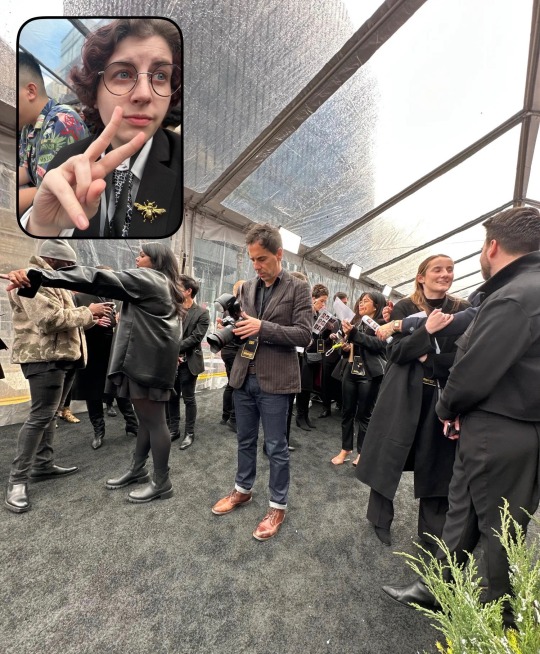

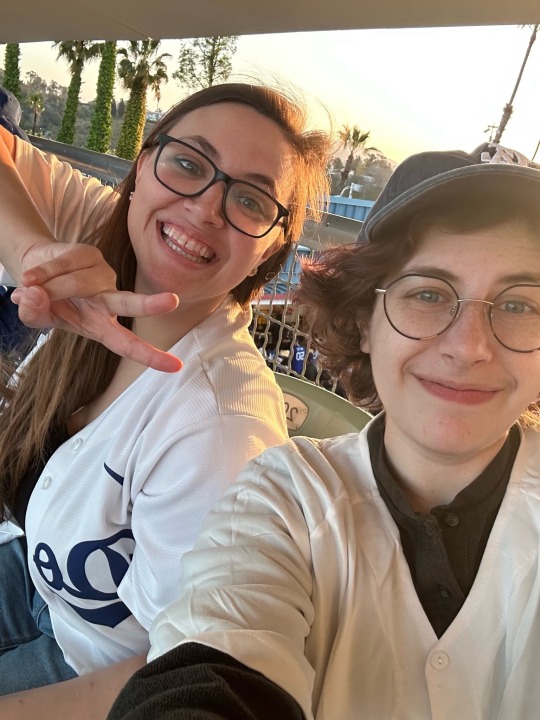


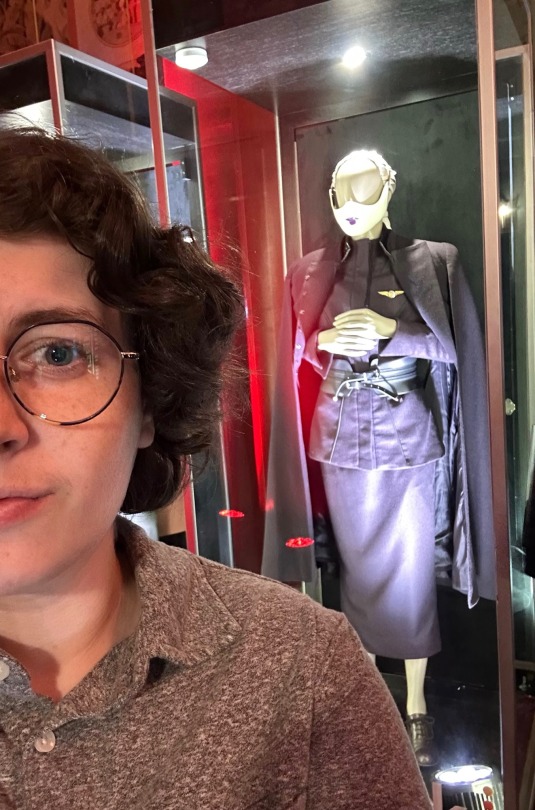


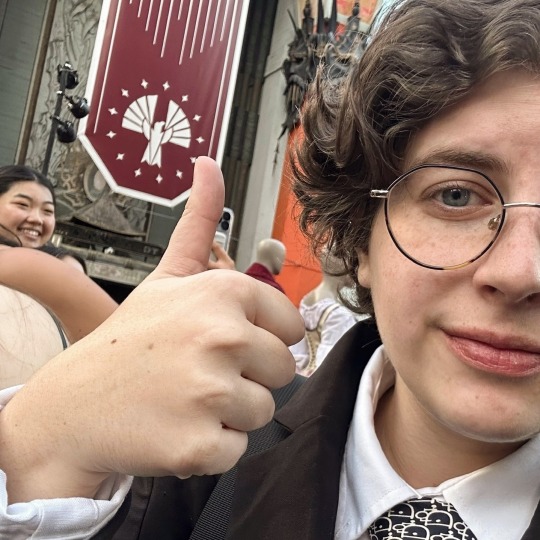

5 notes
·
View notes